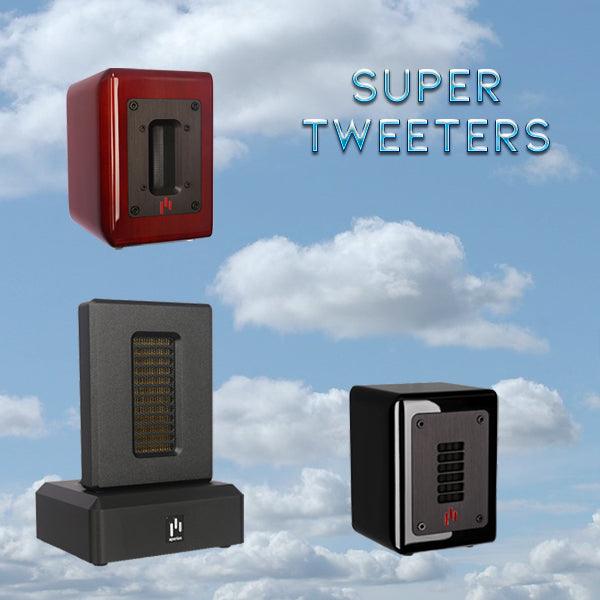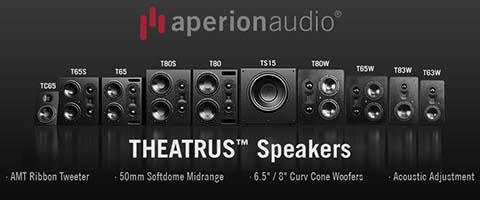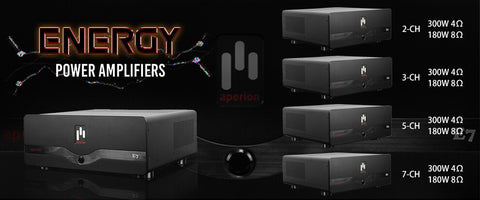By Oliver Amnuayphol - Home Theater Guru
- - - - - - - - - - - - - - - - - - - - - - - - - - - - - - - - - - - - - - - - - - - - - - - - - - - - - - - - - - - - - - - -
Soundbars are the latest speaker system technology that feature a full-range speaker array in a compact cabinet to match flat-panel TVs aesthetics, but they can’t replicate the full theater-like experience you get from multiple speakers. So when does a soundbar make sense for you? They are the perfect solution if you’re looking to do one or more of the following:
- Add sound to a small second room or bedroom and already have a full home theater setup in your main room;
- Your significant other has nicely informed you that there will be no more box speakers in the home;
- Improve on the sound of your TV’s built-in speakers, but your room can’t accommodate a surround-sound setup or you want a simple aesthetic for your room;
- Add a sound package that’s streamlined and easy for others to use;
- Find a solution that takes up very little space or is easily wall-mountable;
- Get sound into a second home, vacation or rental property where you don’t need a full surround setup.
- - - - - - - - - - - - - - - - - - - - - - - - - - - - - - - - - - - - - - - - - - - - - - - - - - - - - - - - - - - - - - - -
Active or Passive?
Generally soundbars come in two flavors—active or passive. Most often, though, soundbars are active, which means they contain all of the electronics needed to produce sound and don’t require an A/V receiver to work: you simply hook up your components (TV, Blu-ray player, cable box, etc.) to the soundbar, turn it on, and just add the popcorn and the movie. On the other hand, a passive (non-powered) soundbar contains just an array of speakers, which can be a great choice if you already have an A/V receiver.
- - - - - - - - - - - - - - - - - - - - - - - - - - - - - - - - - - - - - - - - - - - - - - - - - - - - - - - - - - - - - - - -
Stereo or Surround?
If you’ve ever heard stereo sound through two front speakers, you’re already familiar with what a stereo soundbar does: it produces a front stage of sound from two discrete left and right channels. A few soundbars also add center channel sound for a Left-Center-Right front stage, and will do a great job of following sounds that move across the screen. This works great for basic sound, but what about room-filling surround sound? Great news – many soundbars can also process fairly convincing surround sound effects and can do so in two different ways: either with simulated surround technologies, such as virtual surround or digital sound projection (see “Demystifying Simulated Surround” below), or by offering external, rear-surround speaker connections, or both. Note that even though a soundbar may use some form of front surround, that’s no guarantee it will decode Dolby Pro Logic, Dolby Digital, or DTS signals: the soundbar must have digital inputs and specific decoding to process these surround formats, otherwise, the soundbar may create some form of “matrix” surround which may or may not deliver a convincing and consistent surround effect on all movies. Also note that if you’re considering a soundbar that requires external speakers for surround, you’ll experience heightened surround effects with separate speakers, but you’ll still have to run wires for these speakers and have amplification to power them; if you’re interested in a passive soundbar with external speaker surround, an A/V receiver will definitely be required.
- - - - - - - - - - - - - - - - - - - - - - - - - - - - - - - - - - - - - - - - - - - - - - - - - - - - - - - - - - - - - - - -
Demystifying Simulated Surround
So exactly what is simulated surround? It’s a sound processing technology that attempts to trick your ears into experiencing multichannel surround sound from only a front speaker source. This is done by manipulating certain psychoacoustic auditory cues—such as differences in volume level, time delay, and sound reflections—to create surround effects you’ll perceive as originating from around the room instead of in front of you. Basically, there are two kinds of simulated surround effects processing that we’ll call virtual surround processing and digital sound projection for a lack of standardized names. We’ll briefly describe each technology below:
- - - - - - - - - - - - - - - - - - - - - - - - - - - - - - - - - - - - - - - - - - - - - - - - - - - - - - - - - - - - - - - -
Virtual Surround Sound:
Virtual surround sound uses sound processing algorithms based on head-related transfer function to create a surround sound field effect from only 2 or 3 front channels (L+R or L,C,R). Many virtual surround algorithms, including Euphony HD, Dolby Virtual Speaker, and Qsurround, work in conjunction with discrete Dolby or DTS-encoded signals for a more realistic surround experience. Because virtual surround only needs two to three channels of drivers, many soundbars utilizing this technology can be made very thin and compact (and lower in cost) while still delivering a highly convincing surround effect. What’s more, since virtual surround does not require reflective walls to perform its magic (unlike digital sound projectors); virtual surround will sound great in typically furnished rooms or smaller spaces within open floor plans. There are some drawbacks to virtual surround when compared to discrete surround: it can’t match the realism, impact and sheer scale of a full surround speaker setup, and the surround effect increasingly diminishes the further you sit from the center. But if you’re looking for a reasonably-priced surround experience without putting speakers all over the room, be sure to look at a soundbar with virtual surround processing.
Digital Sound Projection:
Digital sound projectors utilize multiple focused-dispersion speakers to aim sounds in different directions: front stage sounds are firing directly in front of you, while surround effects are reflected to the sides and off the walls. Since the rear channel sound is delayed and reaches your ears from indirect angles, the sound seems to wrap around you in much the same way as a multi-speaker system. What’s more, digital sound projectors can also direct discreet, multi-channel signals to individual speaker drivers for channel separation closer to a multi-speaker setup. The benefit of this type of front surround is a more expansive and immersive sound field and possibly greater detail and clarity; sound projection also works well if you’re sitting somewhat off-center from the soundbar. But since sound projectors require many more drivers than virtual surround soundbars to be effective, the drawback is a physically larger soundbar that carries a much higher price: premium digital sound projectors, such as those from Yamaha and B&W, typically cost at least twice as much as their virtual surround counterparts and sometimes well in excess of premium multiple speaker systems. What’s more, sound projectors rely heavily on the user having bare, reflective walls, so think twice if you have furnished sidewalls (or no sidewalls at all). But do consider a soundbar with digital sound projection if your goal is the most front surround effects possible and are willing to pay a premium for it.
- - - - - - - - - - - - - - - - - - - - - - - - - - - - - - - - - - - - - - - - - - - - - - - - - - - - - - - - - - - - - - - -
How Low Can It Go?
No matter how good a given soundbar may sound, all of them fall short of reproducing low bass frequencies due to their physical size constraints. So if you’re looking for the most thrilling, dynamic and full-range sound possible, make sure to look for a soundbar that comes with a subwoofer (or has a connection for one you’d like to use): visceral deep bass performance is what turns a good soundbar experience into a great one. Moreover, many of today’s subwoofers are surprisingly compact and can usually be tucked away in a corner or under a table for minimum visual impact. And since most subwoofers are self-powered, there’s no need for external amplification or an A/V receiver if you already have a self-powered/integrated soundbar: just plug in the sub’s power cable and run a single wire for the signal. Or, if you don’t want to figure out how to hide another signal cable, use a wireless adaptor like Aperion’s Home Audio Link and get the flexibility to place the sub almost anywhere you like in the room. You can even use the wireless adaptor if you already have a sub you’d like to use with your soundbar.
- - - - - - - - - - - - - - - - - - - - - - - - - - - - - - - - - - - - - - - - - - - - - - - - - - - - - - - - - - - - - - - -
Hook Up and Placement Options
If you want to hook up multiple sources to your soundbar (like cable or dish, Blu-ray player, iPod, XM/Sirius tuner, etc.), make sure the soundbar you’re considering has enough inputs to accommodate all of your equipment. A front panel iPod input and a headphone output for late night listening are also convenient if you plan on using these items, and some soundbars even feature virtual surround processing on the headphone jack. Look for a soundbar that has coaxial or Toslink fiber optic digital inputs and decoding Dolby or DTS signals for front surround. Lastly, many soundbars can be easily placed on a shelf or TV stand, but if you’re looking to wall mount one make sure it either has provisions for this or includes a suitable mount.
- - - - - - - - - - - - - - - - - - - - - - - - - - - - - - - - - - - - - - - - - - - - - - - - - - - - - - - - - - - - - - - -
So to recap, here’s what to consider when choosing a soundbar:
- Choose an active, self-powered soundbar for an all-in-one solution; choose a passive model if you’re hooking one up to your existing A/V receiver.
- Look for a stereo-only soundbar if your goal is simply to get better sound from your TV; look for front surround processing or surround speaker hook-ups for a more immersive, theater-like experience.
- Choose a soundbar with virtual surround for the slimmest form factor and best price/performance ratio; choose digital sound projection if size and budget is not a consideration.
- For full range sound with minimum visual impact, look for a soundbar packaged with a subwoofer.
- Make sure the soundbar you choose has enough connections for all your gear.
We hope this helps you narrow down your decision. Cheers, and happy listening!

Complete Your Sound System Solution

Sign up for our newsletter below, and join our social media groups to stay up to date with the latest news and information from Aperion Audio!
 |
 |







 https://www.aperionaudio.com
https://www.aperionaudio.com